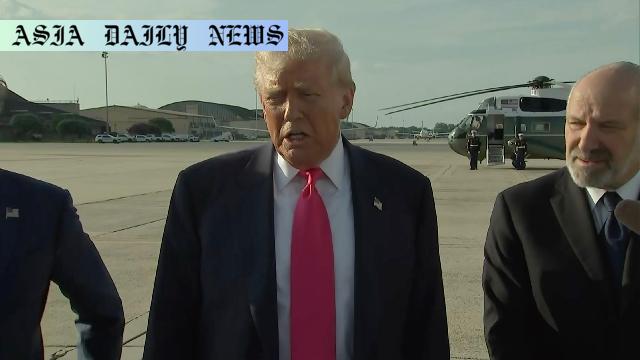Japan Trade: US President Donald Trump accuses Japan of refusing to open its markets and threatens higher tariffs on imports.
Trump criticizes Japan for not opening its markets to US goods.
Threatens a 25% tariff on Japanese imports starting August 1.
Japan remains committed to negotiating a trade deal beneficial to both nations.
The US imports large volumes of Japanese cars, but Japan avoids US vehicle imports.

President Trump’s Criticism of Japan’s Trade Policies
On Tuesday, US President Donald Trump reignited his criticism of Japan’s trade policies, accusing the nation of refusing to open its markets to US goods. Speaking at an air force base near Washington, he expressed dissatisfaction with Japan’s trade practices and their reluctance to allow equal market access. This is not the first time Trump has directed heat toward Japan; recently, he has made a series of similar negative remarks, emphasizing what he views as a trade imbalance and lack of reciprocity.
Proposed Tariffs on Japanese Imports
Trump also made it clear that he is prepared to take strong action should Japan continue its closed-market stance. A 25% tariff on Japanese imports is looming, with August 1 set as the potential implementation date. This proposed measure appears to be aimed at pressuring Japan to comply with US demands for a more balanced trade partnership. The president cited significant US imports of Japanese automobiles, pointing out the comparative absence of American vehicles in Japan’s market as evidence of an unequal relationship. Trump’s tough tone underscores his prioritization of ‘America First’ policies on global trade stages.
Japan’s Response: Pursuing Balanced Negotiations
Despite the sharp criticism, Japanese officials, including Deputy Chief Cabinet Secretary Aoki Kazuhiko, responded with diplomacy. Aoki reaffirmed Japan’s commitment to working toward a mutually beneficial agreement, emphasizing the importance of protecting national interests while satisfying both parties. He has refrained from making any premature judgments about the trajectory of ongoing negotiations.
The Broader Context of US-Japan Trade Relations
The tension highlighted by Trump’s recent remarks reflects deeper challenges in global trade relations and the balancing of national interests. Trump’s administration is spearheading efforts to address what it perceives as unfair trade practices across major economic powers, including Japan and the European Union. This focuses not only on structural trade deficits but also on opportunities for American industries, particularly in agriculture, automotive, and technology sectors.
However, Japan’s trade practices often stem from different economic realities and consumer preferences. The nation’s automotive market is a clear example of this, where Japanese car manufacturers have gained dominance not solely due to closed markets but also because of their high quality and efficiency. Conversely, American automobile brands have struggled to carve out comparable market share in Japan.
Ultimately, while the US and Japan remain crucial trade partners, Trump’s persistent criticism places additional strain on this historically strong alliance. With negotiations ongoing, it remains to be seen whether the two nations can bridge their differences and achieve a favorable outcome.



Commentary
Understanding Trump’s Perspective on Trade
President Trump’s criticism of Japan’s closed-market policies reflects his broader ideology of prioritizing American sovereignty in global trade. He perceives significant economic disparities and trade imbalances as a direct threat to American industries and workers. His administration’s approach to global trade consistently underscores a protectionist stance, aimed at cutting deficits and boosting domestic job creation.
However, whether this approach effectively incentivizes foreign nations to change their trade policies is a matter of debate. While threats of tariffs, like the proposed 25% levy on Japanese imports, may pressure partners to enter negotiation tables, they can also create tensions. The future of diplomacy often hinges on how both sides of such disputes choose to approach discussions and find common ground.
Challenges Facing Japan’s Response
Japan’s response, as articulated by Deputy Chief Cabinet Secretary Aoki Kazuhiko, reveals a nation walking a delicate tightrope. While Japan remains eager to strengthen its relationship with the US, its leadership prioritizes national interests and economic sovereignty. The country’s reliance on exports, coupled with its unique market conditions, amplifies the stakes in this trade conflict.
Aoki’s statement emphasizes Japan’s willingness to negotiate, but the limited scope for compromise could influence the longevity of talks. If the US insists on disproportionate advantages for American goods, the negotiations could face significant hurdles, leaving both sides further entrenched in their positions.
The Path Forward
Finding a resolution to US-Japan trade tensions will require thoughtful diplomacy and an acknowledgment of the legitimate concerns on both sides. For the US, creating competitive products that resonate with Japanese consumers may play an equally important role as negotiating policy changes. For Japan, ensuring that trade agreements do not undermine critical sectors is essential for maintaining domestic stability and securing a broader economic vision.
Ultimately, while Trump’s criticism highlights real challenges in current trade relations, the tone and methods of negotiation will determine if this leads to positive change or protracted conflict. A focus on balanced agreements, mutual respect, and long-term benefits for both nations will be crucial to sustaining a healthy partnership.